Abstract
The Baikouquan Oilfield is entering middle and later periods of development. Casing failure, caused by the quality of cementing and casing corrosion, affects the normal production of the well. The number of wells in this situation has been increasing in recent years. Some wells with a high aquifer have no way to achieve effective plugging. The conventional measures have short validity periods and low plugging strengths. They cannot meet the requirements of subsequent fracturing operations and long-term production. Therefore, a new type of plugging agent with high strength, temperature resistance, salt resistance and micro-expansion features was designed and developed. The field test was carried out on four wells in the Baikouquan block, including three wells with a strong water-flooded layer and one well with an upper casing leakage point. A field test showed that the leakage formation was successfully plugged under the condition that the oilfield pressure test value was 30 MPa, with a 100% success rate. The average fluid volume decreases by 51.4%, and the average oil volume increases by 270.8%. The average daily oil volume per well increases by 3.2 t/d. The new plugging agent has the characteristics of no regurgitation, fast cementing speed with the new interface, high cementing strength and construction safety. The above advantages are of great significance in reducing the operation cost of oil and water well production and enhancing oil recovery.
1. Introduction
With the deepening exploration and development of oilfields, the contradiction between wellbore technology and production is increasingly prominent. First, the prolonged use of casing causes serious aging. In addition, the casing undergoes severe corrosion under the influence of downhole factor interactions, and the factors include high temperature, high pressure, high salinity and so on. The above two points cause corrosion perforation and leakage of casing [1,2,3,4,5]. Figure 1 shows the corrosion perforation and leakage of the casing caused by the above two points, which causes a single well to produce only water but not oil. There are a total of 43 wells with this problem, accounting for nearly 7% of normal wells. Second, because the profile of the oil well is unevenly utilized and the medium and the weak water-flooded layer was not effectively used, it is necessary to strongly plug the water-flooded layer to realize fine digging of the remaining oil [6,7]. Third, the unbalance of ground stress is caused by the action of formation, which causes extrusion load to the outer wall of the casing. The large stratigraphic dip produces uneven squeezing and dislocation load to the outer wall of the casing. At the same time, follow-up stimulation treatment and fracturing operations exacerbate stratigraphic dislocation. These factors lead to deformation and fracture of the casing [8,9,10,11]. Fourth, mechanical damage to the casing is caused during casing running because of the deviation existing between the well inclination angle, azimuth angle and operational requirements for the bending section of the casing and rough/poor construction quality of well cementation, which leads to casing failure [12,13]. Fifth, the span of the oil layer is large, and it is difficult to reconstruct the lower formation, for which reason the lower formation cannot be effectively used. Therefore, in order to meet the requirements of long-term production and subsequent fracturing, it is necessary to plug wells with casing damage, such as corrosion perforation, casing deformation and casing faults, and wells with outside casing channeling and interlayer channeling [14,15,16,17,18] as shown in Figure 2. How to effectively and successfully plug a well with damaged casing and leakage formation to increase single well production is still an urgent problem to be solved in the process of oilfield development.
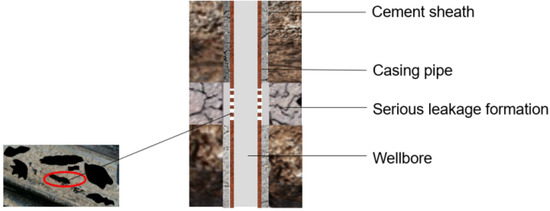
Figure 1.
Schematic diagram of downhole casing leakage.
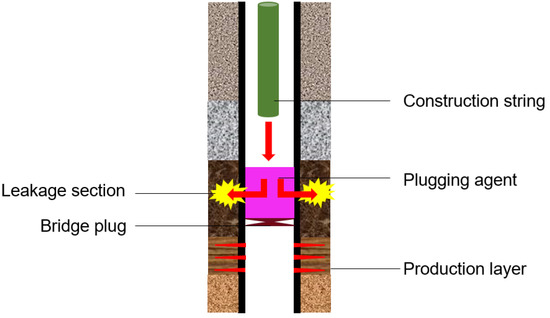
Figure 2.
Schematic diagram of plugging operation.
The existing casing leakage repair measures, including the casing subsidy method, suspending packer and installing new casing to replace the previously damaged casing, can not only dissatisfy the requirements of subsequent fracturing and water injection measures but also has the problems of low success rates of plugging, high construction cost and long construction times [19,20]. The cost of conventional cement plugging is low, but the amount of cement used in plugging operations is large. The solidified body has relatively poor strength and cementation after plugging. In addition, the volume of cement plugging agent is susceptible to shrinkage and can crack at high temperatures, which reduces the structural compactness of the cement solidified body, resulting in plugging failure [21,22,23]. Based upon the conditions described above, chemical plugging agents have been developed. At present, there are many kinds of chemical plugging agents. For example, Fan et al. [24] developed a polymer plugging gel for fractured strata, named XNGJ-3. In the study by Lai et al. [25], a temporary plugging agent composed of two different types of guest molecules for thermally induced phase change fracturing was constructed. In addition to gel plugging agents, researchers have also performed a lot of research on resin plugging agents. For instance, Di et al. [26] developed a composite plugging agent with water-absorbent swelling resin for drilling plugging. Nowadays, inorganic gel plugging agents and thermosetting resin plugging agents are mainly used.
However, these two kinds of plugging agents cannot be effectively retained in the plugging layer, resulting in long injection times and large injection volumes of the plugging agent. The cemented surface between the solidified body formed by the plugging agent and the surrounding medium is not firm, and the bond strength and plugging strength (The bearing capacity of the plugging agent solidified body in the leakage layer) [27] are low. A hydration reaction occurs before the plugging agent enters the leakage layer, which results in a rapid solidification phenomenon. The plugging agent cannot maintain fluidity for a long time, causing construction difficulty. Temperature resistance, salt resistance and drillability have resulted in their limited applications [28,29,30]. Moreover, under the existing plugging technology, the pressure-bearing capacity after plugging cannot meet fracturing requirements. For example, aiming at a well with a large span of oil layers, in order to carry out high-volume fracturing with the deeper formation without cementing, it is necessary to implement high-strength plugging for the upper formations that have been perforated. The plugging agent solidified body should satisfy the pressure-bearing capacity of fracturing. As a result, the deeper formation cannot be effectively used [31].
In view of the above problems, combined with the construction situation of the Baikouquan Oilfield, with temperatures of 40–120 °C and salinity up to 1.5 × 105 mg/L, a new type of micro-expansion chemical plugging agent with effective residence at casing damage locations, high bond strength at interfaces and a long period of effective plugging segments was developed. Its application has made great breakthroughs in repairing casing damage, block channeling and water plugging in the Baikouquan Oilfield. The research shows that new plugging agents applied in the Baikouquan Oilfield have a broad application prospect in oil field development.
2. New High-Strength Plugging Agent
Design concept. The equipment used in the project must have these characteristics: First, the strength and toughness of the bond between the solidified body and the surrounding media can be evaluated. Second, it can simulate complex conditions of the downhole and evaluate the plugging effect of the plugging agent. Third, the bearing capacity of the instrument is greater than 30 MPa and the test temperature of the instrument is greater than 90 °C. Fourth, the instrument is resistant to corrosion.
The properties of the plugging agent. After the plugging agent enters the plugging layer, it can form an interpenetrating network quickly. Thus, it is effectively trapped in the plugging layer and has the ability to resist channeling. The solidified body formed in the plugging layer has the characteristics of high strength, good toughness and micro-expansion. The oil fields have the problem of high salinity and low temperatures. Therefore, the plugging agent must have the characteristics of salt resistance and temperature resistance. Prepared slurry has good fluidity, and it is easy to adjust and stabilize the curing time.
Compositions and their ratio. The plugging agent is mainly composed of sulphate aluminate special cement, and a variety of materials are added, such as interfacial reinforcing agent, toughening agent, structure promoter and nano-active filler. These materials are made into plugging agents by fine processing. Its appearance is that of a gray-brown powder. The main components [32,33,34,35] are sulphate aluminate special cement 70–80%; rigid particles of calcium carbonate, silica powder, blast furnace slag powder, straw ash 10–20%; glass fiber, ceramic fiber, wood fiber, asbestos fiber 10–15%; sepiolite powder, diatomite powder, gypsum, magnesium powder 5–10%; and a properties modifier. Among them, the construction performance regulators include fluid loss additive [36,37], dispersant, retarder, accelerator and defoamer 5–10%. According to the needs of the site, different densities of plugging agent slurry with favorable suspensibility and liquidity were prepared.
Characteristics. From the appearance, the plugging agent is a grayish-brown powder. The particle size distribution of the powder is 8–2500 μm. The prepared fluid is similar to cement slurry. The density of the slurry prepared is between 1.45 g/cm3 and 2.60 g/cm3.
3. Performance Evaluation by Laboratory Tests
Plugging Strength. The strength of the plugging agent in a leakage environment is a key parameter of new micro-expansion plugging agents. In order to evaluate the plugging capacity, the laboratory test was carried out by simulating the lost formation with the bearing-capacity test apparatus, which can simulate a complex downhole environment. The plugging agent pressure-bearing capacity test apparatus and test process are shown in Figure 3 and Figure 4. The specific experimental method for pressure-bearing capacity of the plugging agent experiment and performance evaluation of plugging agent were as follows:
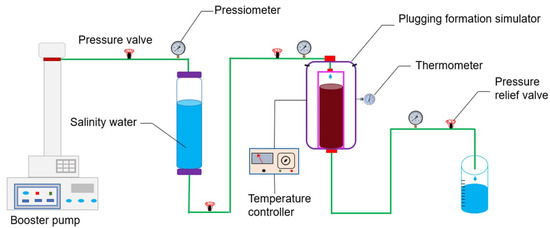
Figure 3.
Apparatus for plugging strength simulation experiment.
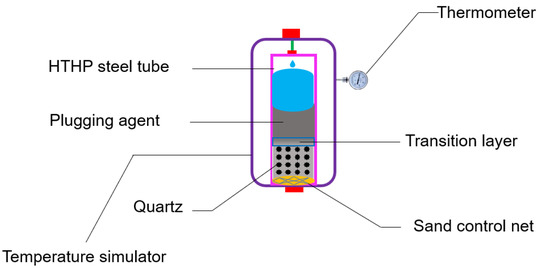
Figure 4.
Apparatus for plugging formation simulation.
- (1)
- The electronic balance YP3002 from Shanghai Youke Instrument Co., LTD. was used to weigh the appropriate amount of plugging agent powder, and the plugging agent was stirred evenly by electric mixer D90-A from Qingdao Haitongda Special Instrument Company Ltd. According to different water-cement ratios, the plugging agent slurries with different densities of 1.55 g/cm3, 1.65 g/cm3, 1.70 g/cm3 and 1.75 g/cm3 were prepared, respectively.
- (2)
- The steel pipe was fixed with a core holder, and a sand control net was placed at the bottom of the steel pipe. Subsequently, on-site formation water with a salinity of 1.5 × 105 mg/L was used to saturate the quartz sand. A certain mesh and particle size of quartz sand were filled into the steel tube uniformly to simulate the Baikouquan Formation with a porosity of 12% [38], and the prepared plugging agent slurry was filled into the steel tube.
- (3)
- The booster pumper and the pressure valve were opened in turn. The pump pressure was adjusted and maintained at a certain pressure to simulate the wellbore conditions at the construction site. At the same time, the temperature simulator was turned on to select different temperatures to simulate the formation environment. The solidified body of plugging agent was maintained under pressure for 48 h under this condition.
- (4)
- The experimental temperatures were selected as 40 °C, 60 °C, 80 °C, 100 °C and 120 °C, respectively. The booster pumper and the pressure valve were opened in turn to adjust the pump pressure. Water with different salinities was passed through the solidified body and the simulated formation under water pressure.
- (5)
- When the first drop of water drops out, the pressure displayed by the pressure meter is the breakthrough pressure, which is also called plugging strength. As water pressure increases, breakthrough phenomena become more obvious. When the pressure suddenly displays zero, this is the maximum pressure, and it is called the breakdown pressure.
- (6)
- In this step, the plugging agent with a density of 1.70 g/cm3 was used. In order to study the effect of time on plugging effect, the plugging strength corresponding to the curing time of 0.5 weeks, 1 week, 5 weeks, 10 weeks, 15 weeks, 20 weeks and 25 weeks was measured under the conditions that the curing temperatures were 80 °C and 100 °C, respectively, referring to the above procedure.
Expansion performance of plugging agent. The expansion rate was measured by an HTP-3 high-temperature and high-pressure intelligent expansibility instrument produced by Qingdao Hengtaida Electromechanical Equipment Co., LTD. [39]. The test conditions selected were as follows: the pressure was 3 Mpa, the temperature was 80 °C, and the density of plugging slurry prepared with water of 1.5 × 105 mg/L salinity was 1.65 g/cm3. Then, the expansion rate of the plugging agent over time was measured.
Rheological properties of plugging agent. In this experiment, different densities of plugging agent slurry commonly used in the field (1.45 g/cm3, 1.60 g/cm3, 1.70 g/cm3) were prepared. The rheological properties of plugging agent slurries were measured by ZNN-D6 six-speed rotary viscometer from Qingdao Jiaonan Analytical Instrument Factory. The data for initial gel strength, final shear force, dynamic shear force, plastic viscosity and apparent viscosity of plugging agent slurry were obtained at room temperate.
Salt resistance of plugging agent. The plugging slurry with a density of 1.65 g/cm3 was prepared with different salinities of water. The salinities of water selected in this experiment were 5.0 × 104 mg/L, 1.0 × 105 mg/L, 1.5 × 105 mg/L and 2.0 × 105 mg/L. The curing temperature was chosen to be 100 °C. Referring to the procedure of plugging strength, the plugging strength with different salinities was measured.
Plugging strength of plugging agent. The plugging strength of the plugging agent varying with temperature and density is shown in Figure 5. The plugging strength of the 1.55 g/cm3 plugging agent slurry can reach 32 Mpa after curing under the condition of high salinity formation (1.5 × 105 mg/L) and a temperature of 40 °C. Under the same conditions, the plugging strength of the plugging agent with a density of 1.75 g/cm3 is 45 Mpa. The plugging strength increases with the increase in plugging agent density and with the increase in simulated formation temperature. The plugging strength of the plugging agent solidified body continues to increase rather than decrease. In the temperature range of 40–80 °C, the rising rate of plugging strength increases rapidly, whereas in the temperature range of 80–100 °C, the rising rate of plugging strength slows down. The rising curve of plugging strength at 100–120 °C approximates the horizontal line, which indicates that the plugging strength tends to be stable. Among them, the plugging strength of the plugging agent with a density of 1.75 g/mg3 is 53 MPa at 120 °C, which can meet the subsequent conventional fracturing operation of a wellbore. The data in the figure are summarized as follows: The plugging strength of the plugging agent with a density of 1.55 g/mg3 is 32 MPa at 40 °C. At the moment, the plugging strength of the plugging agent with a density of 1.75 g/mg3 is 44 MPa. At the same experimental temperature, with the increase in plugging agent density, the plugging strength of the plugging agent increases by 12 MPa. Similarly, the plugging strength increases by 7.5 MPa at 120 °C. It can be concluded from the above results that the plugging strength of the plugging agent increases with its density and experimental temperature. With the increase in temperature, the rising range of the curve decreases and tends to level. It shows that the plugging agent can maintain high plugging strength in high-temperature conditions. It can meet the plugging requirements.
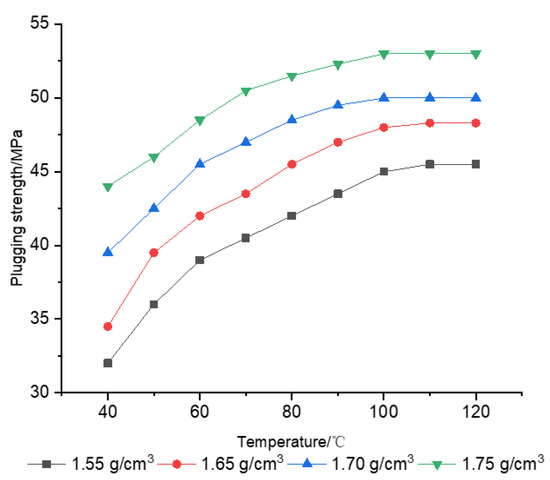
Figure 5.
Plugging strength variation at different temperatures and different densities.
Figure 6 shows the plugging strength of the plugging agent changing with temperature and time. It can be found that the hydration reaction in the plugging agent continued within 15 weeks at 80 °C, the plugging strength of the plugging agent gradually increased within 15 weeks, and it tended to be stable from 15 weeks to 25 weeks. Similarly, it can be concluded that the hydration reaction of the plugging agent continued within 5 weeks at 100 °C, and the plugging strength reached a stable state after 5 weeks. As can be seen from the two curves in the figure, the plugging strength at 100 °C is higher than that at 80 °C. When temperatures get to 80 °C and 100 °C, the curing time reaches 5 weeks and 15 weeks, respectively, in this experimental data. The plugging strength does not change, and it can indicate the structure of the solidified body tends to be stable. These results show that in a high-temperature environment, the plugging strength does not decay but tends to be stable. It shows that the plugging agent has a superior plugging effect and improved the period of validity for field application.
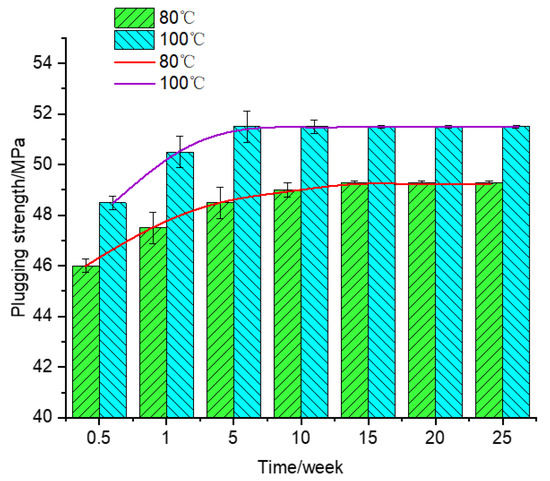
Figure 6.
Plugging strength variation in terms of time at 80 °C and 100 °C.
Based on the above analysis and discussion, the experimental data shows that with the increase in plugging density, the plugging strength is stronger, and the plugging agent presents favorable temperature resistance. Combined with the actual situation, it can be confirmed that the plugging agent has high plugging strength in high salinity formations, which can effectively plug the leakage formation and casing damage, improving its pressure-bearing capacity. In the research by Lu, K [40] and Ba, W [41] on a gel plugging agent, the pressure-bearing capacity of the plugging agent was less than 10 MPa. Chen, S’s [42] research on resin plugging agents shows that the plugging strength can reach 40.65 MPa, but it easily solidifies instantaneously during construction and has poor drillability.
Mechanism of plugging agent. On the one hand, the plugging agent slurry is squeezed into the leakage formations under pump pressure during the repair process of casing damage in wells. The components of the plugging agent slurry are condensed together to extrude part of the free water in the case that the structure promoter is subjected to differential pressure. The different lengths of flexible fibers, rigid fibers, hydration product gels and crystals produced by chemical reactions in the plugging slurry play the role of stretching, winding and so on, which can increase the flow resistance of the plugging slurry in the leakage formation and rapidly form a bonding between the plugging agent slurry and the action layer, limiting its flow to the far formation. It can be concentrated in the leakage layer to play a role in plugging. After the slurry flows into the leakage formation, it preferentially flows into the large channel with little resistance. With the increase in the plugging slurry injection rate, the resistance flowing into the large channel increases, forcing the plugging slurry to flow into the small channel, which plays an effective role in plugging the leakage formation channel. On the other hand, the dense spatial network structure is formed by winding and bridging of active filler, crystal formed by reactions, hydration products, etc., which enhances the plugging effect [43,44]. With the increase in injection pressure, the downhole solidified body has high strength and interfacial bonding strength because of the synergistic effect generated by various materials such as interface strength enhancer, toughening agent, structure promoter and nano-active filler.
Moreover, under the further action of sealing internal pressure, the close contact of the plugging agent particles makes the hydration reaction more complete and the structure of the hydration product more compact, so as to promote the improvement in the strength of the solidified body and interface bonding strength. The expansion active components of the plugging agent further enhance the tightness of the interface cementation through its own micro-expansion [45,46,47]. Therefore, the solidified body after plugging has favorable toughness and flushing resistance, which ensures the reliability and success rate of the plugging operation.
Expansion performance of plugging agent. Figure 7 shows the curve for the expansion rate of the plugging agent over time. It can be found that the expansion rate of the plugging agent increases with the increase in time. The expansion rate increases rapidly from 0 to 6 days, and the rate slows down from 6 to 9 days. The expansion rate of the plugging agent tends to be stable from 9 to 10 days, and the final recorded value is stable at about 4.3%. The experimental results show that the expansion rate of the plugging agent is due to the micro-expansion system. As a result, the plugging agent with the characteristics of micro-expansion is more advantageous than cement for plugging leakage formation and casing damage in wells, because the cement solidified body easily shrinks in field applications, resulting in unsuccessful plugging. The compactness of the solidified body is enhanced by the micro-expansion property of the plugging agent, which improves the bond strength between the solidified body and the formation, casing and cement sheath, reducing the risk of gas channeling [48].
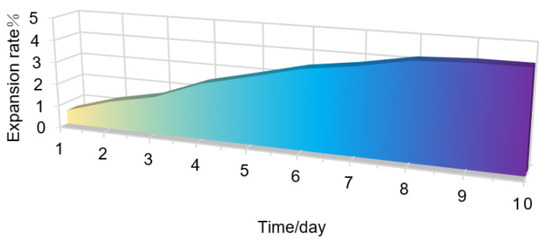
Figure 7.
The expansion curve of plugging agent variation over time.
Expansion mechanism of plugging agent. The new type of micro-expansion plugging agent possesses a certain space network structure and its expansion rate changes with an increase in time at a certain temperature. Through the hydration reaction and water absorption expansion characteristics of the material, the solidified body of the plugging agent can achieve a specific expansion effect within a certain time.
For example, the CaO, Al2O3 and CaSO4 will undergo a hydration reaction to form ettringite when gypsum is added into sulphate aluminum cement. The lattice of the product occupies a larger space than that of the original compound, resulting in an obvious expansion effect [49,50]. The reaction of calcium oxide and magnesium oxide in the plugging material produces calcium hydroxide and magnesium hydroxide, which leads to crystal shape changes and volume increase, resulting in the phenomenon of micro-expansion [51]. The volume expansion of calcium oxide and magnesium oxide also occurs at high temperatures [52]. Besides, the sepiolite powder and wood fiber, etc., easily absorb water to expand [53], which makes the expansion system more stable, to some extent.
Rheological properties of plugging agent. Table 1 presents the rheological property evaluation of plugging agent slurries with different densities at room temperature. The values for each evaluation parameter of the plugging agent slurries increase with the increase in plugging agent slurry density. When the density of the plugging agent slurry is 1.70 g/cm3, the dynamic shear force, plastic viscosity and apparent viscosity of the plugging agent are 12 Pa, 43 mPa·s and 55 mPa·s, respectively. Based on the experimental data, it can be seen that the plugging agent has favorable thixotropy and particle suspension ability, so that the particles cannot settle down in the slurry. The plugging slurry has favorable fluidity, meeting the pumping requirements of the field, which ensures construction safety.

Table 1.
Comparison of rheological properties of different density plugging agents.
Salt resistance of plugging agent. The salt resistance of the plugging agent is shown in Figure 8. It can be seen that when the salinity of water was 0 mg/L, 5.0 × 104 mg/L, 1.0 × 105 mg/L, 1.5 × 105 mg/L and 2.0 × 105 mg/L, the corresponding plugging strength of the solidified body was 48 MPa, 47 MPa, 46.3 MPa, 46.1 MPa and 45.8 MPa, respectively, under the condition that the temperature was 100 °C. The experimental results show that there is little difference in plugging strength at different salinities. The strength variation is less than 3 MPa, which shows that the formation water with different salinities has little influence on the plugging strength of the plugging agent, showing favorable salt resistance.
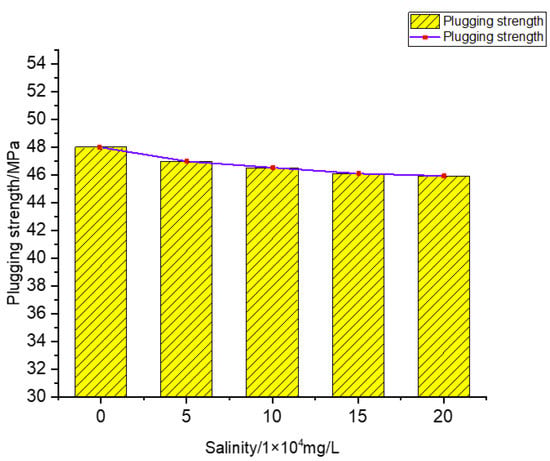
Figure 8.
Salt resistance characteristics diagram of plugging agent.
4. Field Application and Effect Analysis
Taking well 1404 as an example, located in the Bai 21 well area of the Baikouquan Oilfield, Bai 59 Station, which was put into production on 1 November 2008. The drilling depth is 2256 m, twoopen well structure, as shown in Figure 9. The depth of the surface casing is 206.64 m, with the top depth of cement to the ground and the depth of the production casing being 2247.334 m, with the top depth of cement being 815 m. The range of production formation is 2104.5–2181.5 m, with a thickness of 77 m. In order to satisfy production requirements, the supplementary formation 2104.5–2123.0 m was subsequently perforated and produced. Then the phenomena of high liquid production and high water cut appeared in well 1404. The daily liquid production was 26.5 t, the daily oil production was 1.8 t, and the water content was 93.2%. According to the above data, it can be determined that the supplementary formation is the main water outlet layer. It is worth pointing out that the gel plugging agent used previously to solve the high water cut problems had failed to plug the well many times. The problems at the construction site were mainly the retention of the gel plugging agent near the wellbore and the bearing capacity after plugging. Therefore, the plugging agent we presented was used to plug 2104.5–2123.0 m to prepare for the next operation.
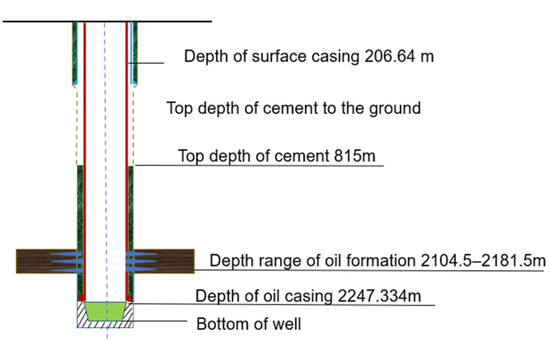
Figure 9.
Well structure of Baikouquan well.
The construction technological process is shown in Figure 10. Pulled out the tubing, and made a wiper trip to the artificial well bottom to ensure the borehole operation channel opened during the construction procedure. The seal packer checking casing was installed at 2100 m, controlling the pressure at 18 MPa to check the qualification of the casing, and the casing was normal. Then, the electric cable bridge plug was installed to make sure the sealing between 2123 m and 2133 m was qualified. In order to prepare the plugging slurry used, subsequently, the formation absorption was tested. The absorption was 300 L/min when the pump pressure was 3 MPa. Therefore, the parameters for the plugging agent slurry used were 1.70–1.75 g/cm3, 9 m3, and a thickening time of 180 min at 50 °C. The depth of the working string sent to the wellbore was 1800 m, pumping in ahead fluid 4 m3, plugging agent slurry 9 m3, overflush fluid 6.5 m3 in turn with positive extrusion, and the plugging slurry level at this time was about 1883 m. Then, 2.2 m3 overflush fluid was pumped in with reverse extrusion, and the plugging slurry level at this time was about 2070 m. Shut in the well, and solidified 72 h under the shutoff pressure. The leakage formation was successfully plugged under the condition that the oilfield pressure test value was 30 MPa, which meets the production requirements.
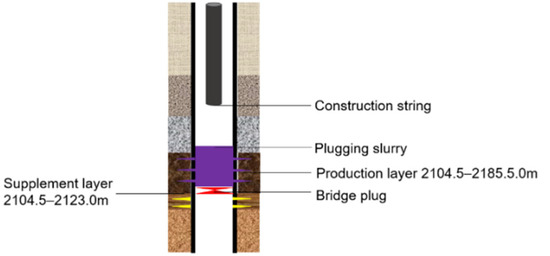
Figure 10.
Process chart of plugging agent construction technology.
The sweeping plug section 2070–2123 m was drilled under a drilling pressure of 1–3 t. The pressure test value for the sweeping plug section was 30 MPa, and the pressure did not drop for 30 min, suggesting that the high water layer 2104.5–2181.5 m was effectively plugged. After treatment, the daily fluid production of the well reduced by 46%, daily oil production increased from 1.8 t/d to 2.5 t/d, and water content decreased by 11.4%. These field data proved that the plugging agent has a favorable plugging effect.
A total of four wells were plugged with the new micro-expansion plugging agent, in the Baikouquan block, including three wells with a strong water-flooded layer and one well with an upper casing leakage point. The field test showed that the leakage formation was successfully plugged under the condition that the oilfield pressure test value was 30 MPa rather than 15 MPa, with a 100% success rate. The average fluid volume decreased by 51.4%, the average oil volume increased by 270.8%, and the average daily oil production of a single well increased by 3.2 t/d. Table 2 shows the comparison of data for pre-construction and after construction.

Table 2.
Comparison of data with pre-construction and after construction.
Researchers have performed a lot of research on plugging agents. For example, Han et al. [54] developed a low-density compound cement plugging agent. The density of the plugging agent is 1.35–1.40 g/cm3, 12 h compressive strength is 3 MPa, and thickening time is 200 min. It was successfully applied in well J59, but it easily solidified instantaneously during construction and had poor bearing pressure ability. Therefore, we have performed a lot of research on new plugging agents. The research and implementation of the project provide a new direction for the reconstruction of damaged wells, improve the effect of reservoir development and enhance oil recovery. A set of plugging technologies suitable for the Baikouquan Oilfield is formed, which provides a reference for similar reservoirs. However, the cost of high-density plugging agents needs to be further reduced. Through the development of this project, the problem of deteriorating well condition can be solved, and the damage to formations can be prevented effectively. The new type of plugging agent has high economic and social benefits, showing a good application prospect.
5. Conclusions
In this work, a new type of micro-expansion plugging agent is proposed as an effective way to plug leakage formation and casing damaged well. More details on plugging agents were summarized, such as the design concept, compositions and their ratios, mechanism and performance characteristics. Among them, the properties of the plugging agent were evaluated, including plugging strength, temperature resistance, salt resistance, expansion and flow performance. The detailed conclusions are summarized as follows:
- (1)
- The plugging agent is made up of a variety of materials, and its density can be adjusted within the required range to meet the plugging requirements for different formations. In addition, it can quickly form a space network structure so as to effectively reside in the plugging position and also has favorable plugging strength, temperature resistance and salt resistance, with long validity after plugging.
- (2)
- Under the condition of high temperature, the plugging strength can remain stable. Under the laboratory experiment conditions, the maximum plugging strength can reach 53 MPa, meeting the requirements of subsequent boosting pressure water injection and conventional fracturing.
- (3)
- The plugging agent has the property of micro-expansion, and the expansion rate is about 4.3%. The compactness of the solidified body is enhanced by the micro-expansion property of the plugging agent, which improves the bond strength between the solidified body and formation, casing and cement sheath, reducing the risk of late annulus pressure and gas channeling.
- (4)
- The plugging agent has favorable thixotropy, particle suspension ability, and favorable fluidity, so that the particles do not settle down in the slurry, meeting the pumping requirements for the field, which ensures construction safety.
- (5)
- The pressure test value for the plugging agent is large after plugging, which fully meets the requirements for site construction. In addition, this plugging technology can be used in cases where some production wells fail to achieve the expected production after fracturing, or casing leakage and casing faults make the fracturing impossible, requiring a rebuild of the wellbore integrity.
The plugging agent presented plays an important role in reducing the production cost of oil and water wells and increases the production by a single well. It explores a new direction for plugging technology, especially in rebuilding wellbore integrity, which has great value for popularization and application.
Supplementary Materials
The following supporting information can be downloaded at: https://www.mdpi.com/article/10.3390/app12168150/s1, Figure S1: Plugging strength variation at different temperatures and different densities; Figure S2: Plugging strength variation in terms of time at 80 °C and 100 °C; Figure S3: The expansion curve of plugging agent variation over time; Table S1: Comparison of rheological properties of different density plugging agents; Figure S4: Salt resistance characteristics diagram of plugging agent; Table S2: Comparison of data with pre-construction and after construction.
Author Contributions
Y.S. was responsible for the conceptualization; visualization; methodology; data analysis; and writing, editing, and review of the original draft. W.Z. performed the whole of the experimental work and drafted this manuscript. Y.H. and R.H. took charge of field testing, field data recording and analysis. S.K. and Y.L. made contributions to the concept and design of this work and approved the final version to be submitted. All authors have read and agreed to the published version of the manuscript.
Funding
The authors acknowledge the Scientific Research Program Funded by Liaoning Provincial Education Department (Grant No.LJKZ0420).
Institutional Review Board Statement
Not applicable.
Informed Consent Statement
Not applicable.
Data Availability Statement
Please refer to the supplementary file.
Conflicts of Interest
The authors declare no conflict of interest.
References
- Yan, W.; Xu, Y.; Zhou, Y.; Wang, K. Investigation of Stress Concentration and Casing Strength Degradation Caused by Corrosion Pits. Int. J. Corros. 2016, 2016, 6930234. [Google Scholar] [CrossRef]
- Lin, T.; Zhang, Q.; Lian, Z.; Chang, X.; Zhu, K.; Liu, Y. Evaluation of casing integrity defects considering wear and corrosion—Application to casing design. J. Nat. Gas Sci. Eng. 2016, 29, 440–452. [Google Scholar] [CrossRef]
- Zhu, X.H.; Sun, R.Q.; Tong, H. A new method to predict the remaining life of corrosion casing for steam injection wells. Mater. Corros. 2013, 66, 175–181. [Google Scholar] [CrossRef]
- Tong, Y.; Yang, Y.; Yang, Z.; Wang, H. Causes of tubing corrosion and perforation in a production well. Chem. Enterp. Manag. 2021, 17, 135–138. [Google Scholar]
- Gong, D.; Yu, S.; Yuan, P.; Shuai, Y. Cause analysis of L80 tubing corrosion perforation. Corros. Prot. 2014, 35, 959–963. [Google Scholar]
- Luo, P. Comprehensive water cut status and development direction of water-flooded zone evaluation technology in Bohai oilfield. Chem. Enterp. Manag. 2016, 29, 195. [Google Scholar]
- Ci, J.; He, S.; Li, Z.; Wang, M.; Cui, J.; Jiang, Y. Present Situation of waterflooded zone logging and its developing trend. Nat. Gas Ind. 2005, 25, 44–46. [Google Scholar]
- Gholami, R.; Rasouli, V.; Aadnoy, B.S.; Mohammadnejad, M. Geomechanical and Numerical Studies of Casing Damages in a Reservoir with Solid Production. Rock Mech. Rock Eng. 2016, 49, 1441–1460. [Google Scholar] [CrossRef]
- Yin, F.; Gao, D. Mechanical analysis and design of casing in directional well under in-situ stresses. J. Nat. Gas Sci. Eng. 2014, 20, 285–291. [Google Scholar] [CrossRef]
- Liu, W.; Yu, B.; Deng, J. Analytical method for evaluating stress field in casing-cement-formation system of oil/gas wells. Appl. Math. Mech. 2017, 38, 1273–1294. [Google Scholar] [CrossRef]
- Li, W.; LI, Y.; Zhang, Z.; Fang, P.; Sun, W. The in-situ stress analysis of casing damage wells in the sixth middle district based on kriging interpolation method. Adv. Pet. Explor. Dev. 2016, 11, 45–49. [Google Scholar]
- Wang, T.; Yang, S.; Zhu, W.; Bian, W.; Liu, M.; Lei, Y.; Zhang, Y.; Zhang, J.; Zhao, W.; Chen, L.; et al. Law and countermeasures for the casing damage of oil production wells and water injection wells in tarim oilfield. Pet. Explor. Dev. 2011, 38, 352–361. [Google Scholar]
- Murtaza, M.; Mahmoud, M.; Tariq, Z. Experimental Investigation of a Novel, Efficient, and Sustainable Hybrid Silicate System in Oil and Gas Well Cementing. Energy Fuels 2020, 34, 7388–7396. [Google Scholar] [CrossRef]
- Han, L.; Yin, F.; Yang, S.; Liu, W.; Deng, Y. Coupled seepage-mechanical modeling to evaluate formation deformation and casing failure in waterflooding oilfields. J. Pet. Sci. Eng. 2019, 180, 124–129. [Google Scholar] [CrossRef]
- Lian, Z.; Yu, H.; Lin, T.; Guo, J. A study on casing deformation failure during multi-stage hydraulic fracturing for the stimulated reservoir volume of horizontal shale wells. J. Nat. Gas Sci. Eng. 2015, 23, 538–546. [Google Scholar] [CrossRef]
- Mohammed, A.I.; Oyeneyin, B.; Atchison, B.; Njuguna, J. Casing structural integrity and failure modes in a range of well types—A review. J. Nat. Gas Sci. Eng. 2019, 68, 102898. [Google Scholar] [CrossRef]
- Zakharov, V.; Ismagilov, A.; Antonov, M. Waterproofing of cracks from the side of injection wells in carbonate reservoirs. Xinjiang Pet. Geol. 2013, 34, 108–110. [Google Scholar]
- Wang, Y. Lost circulation law in fractured strata with stress sensitivity. Xinjiang Pet. Geol. 2015, 36, 450–453. [Google Scholar]
- Feng, X.; Kou, M.; Xiong, S.; He, Z.; Xu, K. Discussion on plugging technology of casing leakage. Drill. Prod. Technol. 2018, 41, 127–129. [Google Scholar]
- Cheng, W. Damage of casing and repair process. West-China Explor. Eng. 2015, 27, 71–72. [Google Scholar]
- Dang, D.H.; Gao, F.; He, J.Y.; Jiang, T.; Yao, B.H. Research and Application of Cement Plugging Techniques in Evaporite Bed of Piedmont Tectonic Belt of the Tarim Basin. Adv. Mater. Res. 2013, 807–809, 2634–2638. [Google Scholar] [CrossRef]
- Qin, J.; Zheng, J.; Li, L. Experimental study of the shrinkage behavior of cemented paste backfill. J. Rock Mech. Geotech. Eng. 2021, 13, 545–554. [Google Scholar] [CrossRef]
- Eloget, M.O.; Abuodha, S.O.; Winja, M.M.O. The Effect of Sisal Juice Extract Admixture on Compressive and Flexural Strength of Cement Concrete. Eng. Technol. Appl. Sci. Res. 2021, 11, 7041–7046. [Google Scholar] [CrossRef]
- Fan, X.; Zhao, P.; Zhang, Q.; Zhang, T.; Zhu, K.; Zhou, C. A Polymer Plugging Gel for the Fractured Strata and Its Application. Materials 2018, 11, 856. [Google Scholar] [CrossRef]
- Lai, N.; Chen, Y.; Wang, J.; Wu, C.; Zhang, X. Temporary Plugging Agent System for Thermally Induced Phase Change Fracturing in Shale Gas Reservoirs. Energy Fuels 2022, 36, 6270–6279. [Google Scholar] [CrossRef]
- Zhai, K.; Fan, S.; Fang, J.; Yu, Y.; Xie, H.; Ma, X. Development and evaluation of composite plugging agent of water-absorbent swelling resin. Oilfield Chem. 2021, 38, 196–203. [Google Scholar]
- Yang, Z.; Li, M.; Guo, J.; Zhang, K.; Lin, W.; Bi, H. Recondition injury casing with plugging agent in oil and water injection wells. Oil Drill. Prod. Technol. 2001, 4, 68–71. [Google Scholar]
- Liu, P.; Wei, F.; Zhang, S.; Zhu, X.; Wang, L.; Xiong, C. A bull-heading water control technique of thermo-sensitive temporary plugging agent. Pet. Explor. Dev. 2018, 45, 536–543. [Google Scholar] [CrossRef]
- Liu, Y.; Xu, T.; Yang, Z. Recent progress on preventing and treating lost circulation domestic and overseas. Drill. Fluid Complet. Fluid 2010, 27, 80–84. [Google Scholar]
- Yang, Z.; Yan, P.; Dong, J.; Chen, Y.; Wang, J.; Huang, Q. Study and applications of the high-efficiently plugging agent for thermal production wells. J. Xi’an Shiyou Univ. Nat. Sci. Ed. 2006, 4, 54–57. [Google Scholar]
- Zhang, R.; Hou, B.; Tan, P.; Muhadasi, Y.; Fu, W.; Dong, X.; Chen, M. Hydraulic fracture propagation behavior and diversion characteristic in shale formation by temporary plugging fracturing. J. Pet. Sci. Eng. 2020, 190, 107063. [Google Scholar] [CrossRef]
- Zhai, K.; Yi, H.; Liu, Y.; Geng, Y.; Fan, S.; Zhu, D. Experimental Evaluation of the Shielded Temporary Plugging System Composed of Calcium Carbonate and Acid-Soluble Preformed Particle Gels (ASPPG) for Petroleum Drilling. Energy Fuels 2020, 34, 14023–14033. [Google Scholar] [CrossRef]
- Corredor-Rojas, L.; Hemmati-Sarapardeh, A.; Husein, M.; Dong, M.; Maini Brij, B. Rheological behavior of surface modified Silica nanoparticles dispersed in partially hydrolyzed polyacrylamide and xanthan gum solutions: Experimental measurements, mechanistic understanding, and model development. Energy Fuels 2018, 32, 10628–10638. [Google Scholar] [CrossRef]
- Yazdanpanah, F.; Sokhansanj, S.; Lim, C.J.; Lau, A.; Bi, X. Gas Adsorption Capacity of Wood Pellets. Energy Fuels 2016, 30, 2975–2981. [Google Scholar] [CrossRef]
- Mi, S.; Li, S.; Wu, Q. Rheology and filtration properties of bentonite-water suspensions as influenced by lignocellulosic nanomaterials and water-soluble biopolymer additives. Energy Fuels 2022, 36, 4479–4490. [Google Scholar]
- Wang, D.; Zhang, J.; Li, L.; Yang, B. Synthesis and evaluation of AS fluid loss additive for cement slurry. J. Liaoning Shihua Univ. 2012, 32, 38–42. [Google Scholar]
- Li, L.; Zhao, L.; Wang, Y.; Wu, J.; Meng, G.; Liu, Z.; Zhang, J.; Hu, B.; He, Q.; Guo, X. Novel Dispersant with a Three-Dimensional Reticulated Structure for a Coal–Water Slurry. Energy Fuels 2018, 32, 8310–8317. [Google Scholar] [CrossRef]
- Jia, B.; Xian, C. Permeability measurement of the fracture-matrix system with 3D embedded discrete fracture model. Pet. Sci. 2022, in press. [Google Scholar] [CrossRef]
- Liu, G.; Hu, S.; Xiang, X.; Luo, C.; Guo, B. Development of JHPZ- High temperature and high pressure intelligent expansibility tester. J. Oil Gas Technol. 2000, 22, 107–109. [Google Scholar]
- Lv, K.; Liu, Y.; Qiao, W.; Liu, Y. Study on high strength pre-crosslinked gel plugging agent. Oilfield Chem. 2011, 28, 359–362. [Google Scholar]
- Ba, W.; Wang, Z.; Wang, C. Study on high temperature resistant compound gel plugging agent. Drill. Fluid Complet. Fluid 2021, 38, 728–731. [Google Scholar]
- Chen, S.; Zhao, K.; Chang, D. Synthesis of phenolic resin prepolymer plugging agent with high strength for oil well plugging. China Synth. Resin Plast. 2015, 32, 30–33. [Google Scholar]
- Yan, P.; Zhou, Y.; Yang, Z. Microstructure and sealing mechanism of high-temperature sealant. J. Mater. Sci. Eng. 2006, 24, 811–814. [Google Scholar]
- Yan, P.; Qin, J.; Yang, Z. Microstructure formation and invalidation mechanism of sealant in the simulated environment at the bottom of oil well. J. Chin. Ceram. Soc. 2002, 30, 423–428. [Google Scholar]
- Lu, P.; Meng, X.; Li, W.; Zhang, A. Laboratory study and evaluation of heat resistant and salt resistant chemical plugging agent for casing damaged wells. Nat. Gas Technol. Econ. 2013, 7, 42–45. [Google Scholar]
- Zhang, Z.; Yan, C.; Yan, Z.; Yang, P.; Yang, C.; Guo, B.; Li, M. Research and application of plugging agent for drilling in overflow and leakage coexisting formation. Nat. Gas Technol. Econ. 2019, 13, 40–44, 81–82. [Google Scholar]
- Tian, L.; Chen, Q.; Liu, Y.; Nian, Z. Evaluation and application of high strength expansion plugging agent for treatment of ultradeep casing damage well. Well Test. 2020, 29, 56–61. [Google Scholar]
- Zuo, J.; Ding, Y.; Yu, H. Hydrating expansion compound plugging technology. Drill. Fluid Complet. Fluid 2006, 23, 56–58. [Google Scholar]
- Opravil, T.; Ptáček, P.; Šoukal, F.; Havlica, J.; Brandštetr, J. The synthesis and characterization of an expansive admixture for M-type cements I. The influence of free CaO to the formation of ettringite. J. Therm. Anal. 2013, 111, 517–526. [Google Scholar] [CrossRef]
- Zheng, H.; Wei, Y. A review of ettringite formation and stability and its influence on material properties. Concrete 2001, 6, 44–48. [Google Scholar]
- Han, G.; Li, F.; Xie, T.; Yang, T. Research and application of micro-expansion plugging technology in casing damaged well treatment. Drill. Prod. Technol. 2019, 42, 112–114. [Google Scholar]
- Singh, A.; Singh, B.P.; Chandra, H.; Shyam, R. Analysis of volume expansion data for periclase, lime, corundum and spinel at high temperatures. Bull. Mater. Sci. 2012, 35, 631–637. [Google Scholar] [CrossRef][Green Version]
- Zhang, J.; Duan, X. Properties of sepiolite and its application. China Non-Met. Miner. Ind. 2009, 4, 19–22. [Google Scholar]
- Han, J. Development and application of a low-density compound cement plugging agent. Technol. Superv. Pet. Ind. 2021, 37, 8–11. [Google Scholar]
Publisher’s Note: MDPI stays neutral with regard to jurisdictional claims in published maps and institutional affiliations. |
© 2022 by the authors. Licensee MDPI, Basel, Switzerland. This article is an open access article distributed under the terms and conditions of the Creative Commons Attribution (CC BY) license (https://creativecommons.org/licenses/by/4.0/).